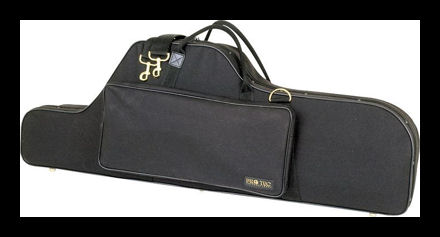The bigger the horn, the more you pay…and pay…and pay…and pay.
When I made the leap and bought my first bari, I knew that I would have to pay more for the horn initially, and as I very quickly found out, I would have to pay more for everything baritone-related from reeds to stands and everything in between. It’s a simple case of economics: There are fewer baritone players around, so that means fewer people to absorb the costs of R&D, manufacturing, etc. etc. Personally, I think some of this is BS, much like current gas prices. Yes things do cost somewhat more, but manufacturers charge more because they can. As bari players, we are held hostage, and don’t have a choice.
Bottom line: baritone sax players get soaked on everything, and this is not limited only to tangibles like mouthpieces, reeds, and ligatures. Repairs on the larger horns cost more too. Also, larger horns are by design more prone to damage through the everyday minor events like bumps, jarring, and collisions (while inside their cases) with door frames.
When I got my low Bb Mark VI, the original case was long gone. The horn came in a relatively new standard Protec PRO PAC case like this one:
This is a good everyday case if you’re looking for something relatively lightweight, that will offer more protection than a gig bag, and won’t kill you in the weight department like the original plywood case will. It will not protect the horn very well though if someone is rough with it, or if things are placed or dropped on it. I see it as a good “all around town” case that I trust, as long as I am in sole control of my instrument.
Protec also makes a contoured bari case that will accommodate both low Bb and A horns.
This is what Protec says about their cases:
In 1977, Protec introduced the PRO PAC, the only hybrid case to combine the protection of a flight case with the convenience of a gig bag. At Protec, we collaborate with professional musicians to understand their needs and wants and we transform these ideas into sophisticated solutions. We’re committed to delivering technology, performance and luxury in a modern and contemporary package.
Alright then, enough of their advertising spiel. “Protection of a flight case” my ass. I don’t know anyone who would be foolish enough to send their horn on a flight in a case like this without the added protection of an Anvil-style case to house it in. ![]()
When the band I was in started to do more traveling, and my bari was no longer always under my control, I decided I needed an upgrade. I opted for the best protection I could get for my horn, and got the BAM Hightech baritone case.
Although the cost of it is more than that of many used, student-model, alto saxophones, it is arguably the best protection you can get for your baritone saxophone. There are some quirky things about the case. For example, when you stand it on its side, the pull handle prevents it from laying flat, so it is not as stable as it could be. But overall, it is a great case. Over the years it has saved me hundreds of $s on repair bills. Since my Selmer has been in this case (February 2004), it has only needed to be regulated once. Until 18 months ago when I got sick, this horn was being used 3 or 4 times a week at rehearsals and shows all over the Lower Mainland. So this case has already seen a lot of traveling and handling both here and back in New Brunswick, and in this time has proven its worth to me in money saved in repair bills.
While I do love the concept of being able to pull the horn, the reality of pulling a fragile baritone over bumpy terrain such as curbs, dips in sidewalks, etc. would be regular trips to the repair shop; no matter how well constructed the interior of the case is. Therefore I still prefer to carry my horn, unless I’m on a smooth surface like carpeting, hardwood, freshly paved blacktop, that kind of thing.
BAM & WJ will soon have some competition in the high-end baritone sax case market. SKB will be introducing a Contoured Pro Bari Case in August 2008. It will be interesting to see how it will compare in features and price to the competition.






Hi Helen,
Thanks for the info. My saxophone quartet are always looking for tips on gear. Nothing worse than being excited about the overseas gig only to arrive with a broken horn!
Cheers
Nigel
http://www.eclipsesaxophonequartet.com
Hi Nigel. Welcome to my site.
My apologies. You ended up in my anti-spam folder for some reason. I just found your note this AM.
Glad you found this post useful.
Regards,
Helen
Thanks. I think i’m going to buy a strong, sturdy flight case. I’ve also read to wrap the sax in bubble wrap. Do you think Selmer cases would be ok?
Thanks again.
Hi Tyler.
Thanks for the comments on my post. I appreciate them.
So for tenor, or any sax big enough that has to be checked for travel by air, the same rules apply re: Anvil or Anvil style cases.
With regards to an inside case, (meaning inside the Anvil case) you have a lot of choices. Protec, BAM, Walt Johnson, etc. etc.
Now, some people have shipped their horns in Walt Johnson cases only, and have had no problems. Others, well they have had problems. It really is a gamble.
Baggage handlers are not gentle with baggage as a rule because they have to handle too much of it. Even buggage properly marked as “Fragile” gets thrown around sometimes.
So in the end I guess word is “You pay your money, you take your chances”. Sorry that I can’t be more optimistic than that. I wish I could be. That’s why people who have been burned once, have opted to go for the security of the bulky flight cases.
No matter what type of case you use, before you travel in ’09, make sure you do some research on how to pack your horn for the trip. There are some really important things that really need to be done, and some key packing materials you need, to make sure your horn arrives as safely as possible at the other end.
Mmmm….Perhaps there’s another blog post for me?
Hope this has been helpful. If you need more info, give let me know. I’ll fill in more of the blanks.
Lots of good info thanks! I play Bb Tenor and my band is going to ireland in march 2009. Do you have any Tenor flight cases that you recomend?
Hi Austin.
I’ve sent you an email with detailed information, so check your Inbox.
Basically you would be looking for either an “Anvil”, or an “Anvil style case”. If you Google those 2 terms you will come up with some information that will help you get started with your search.
If you can find one of these types of cases used, it is always a better option than new, since they are quite costly.
You will however still need a case to put inside of this flight crate….Since you don’t want to get to your destination and be stuck dragging around a heavy, bulky crate with wheels…This is where, depending on your circumstances, the Protec or the BAM, will be a good choice.
Hope this helps…helen
Can you recomend a baritone sax case (low A) that is strong enough to be put in the hold a plane??
Thanks